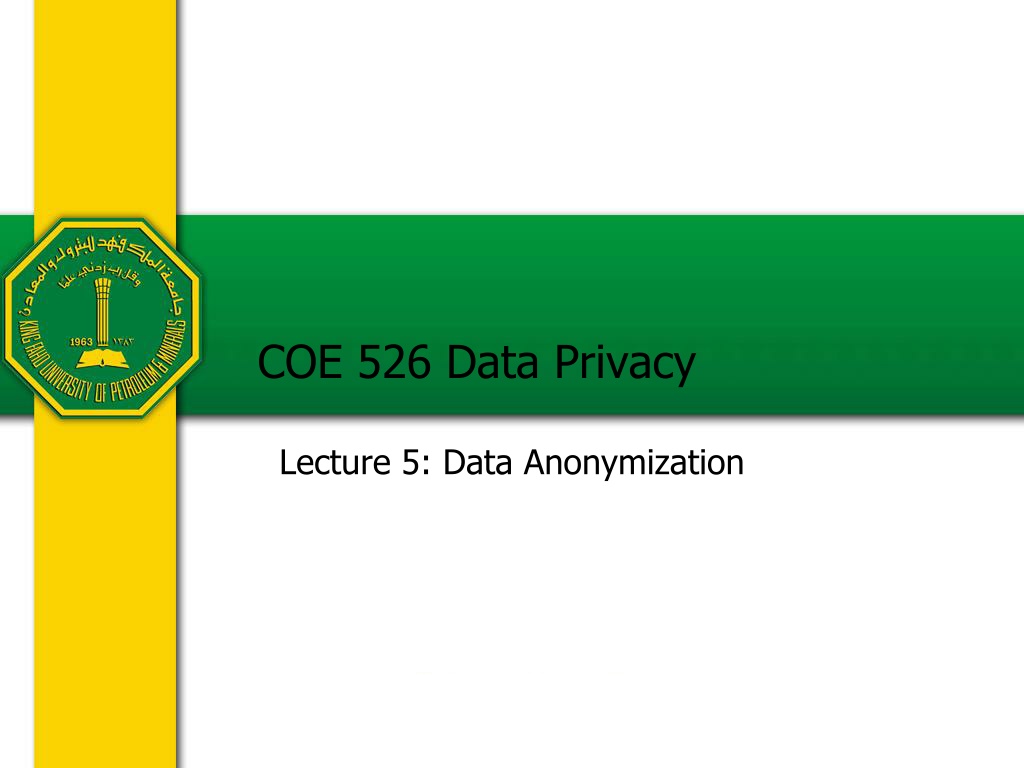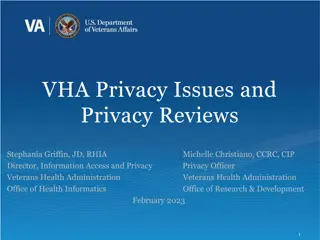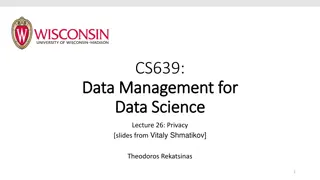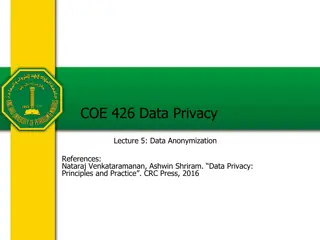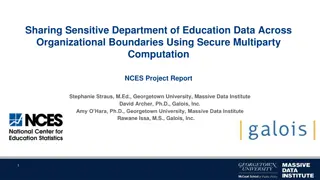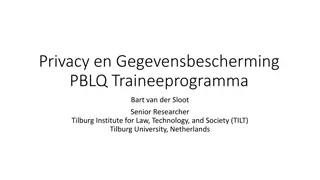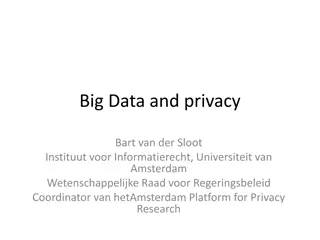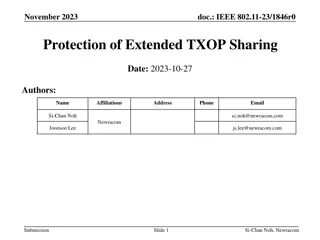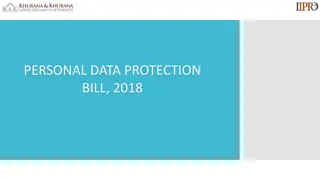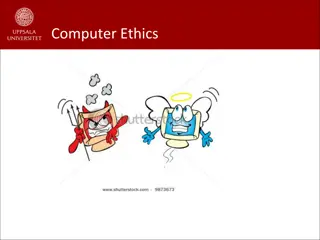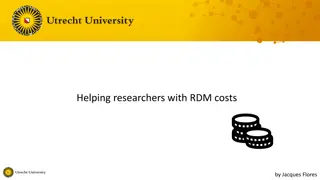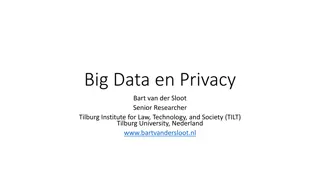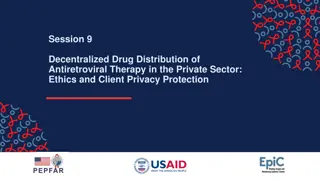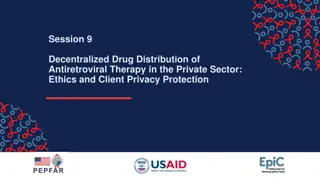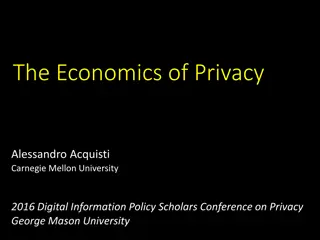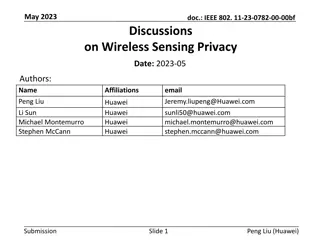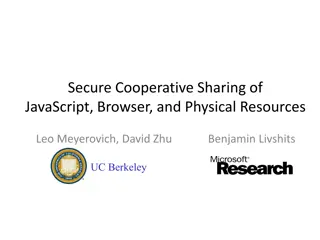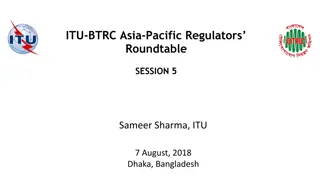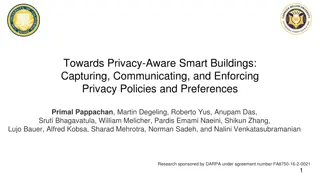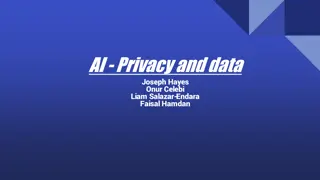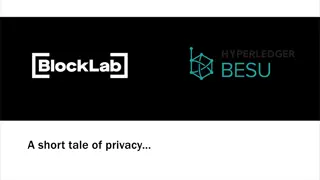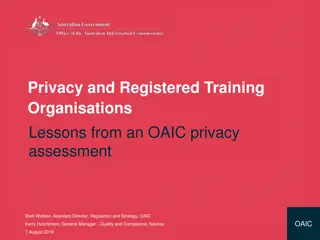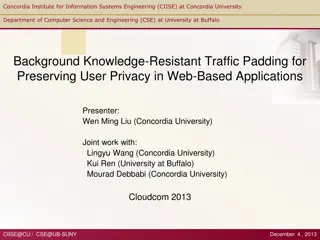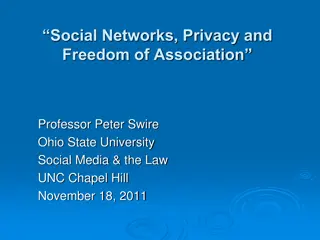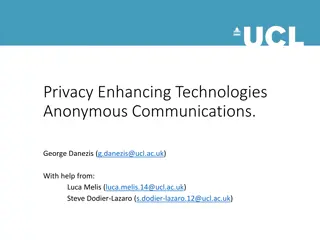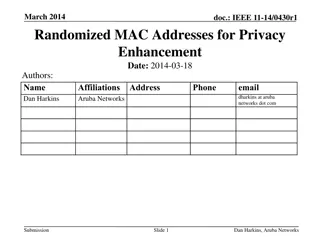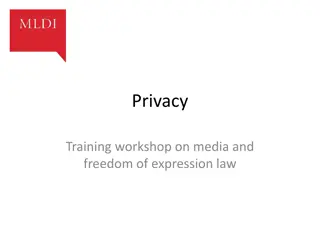Data Privacy in Sharing Sensitive Information
Understanding the importance of data anonymization and privacy requirements in sharing data. Exploring methods like k-anonymization and issues such as data linkage attacks that compromise individual privacy. Highlighting real-life examples like the MA governor's data linkage incident and the Netflix Prize challenge. Emphasizing the need for privacy-preserving data sharing while maximizing data utility.
Download Presentation

Please find below an Image/Link to download the presentation.
The content on the website is provided AS IS for your information and personal use only. It may not be sold, licensed, or shared on other websites without obtaining consent from the author. Download presentation by click this link. If you encounter any issues during the download, it is possible that the publisher has removed the file from their server.
E N D
Presentation Transcript
COE 526 Data Privacy Lecture 5: Data Anonymization
Outline Objective of data sharing (publishing) Privacy requirement for data sharing k-anonymization Definition Methods for k-anonymization Greedy Partitioning algorithm Attacks on k-anonymization Data sharing beyond k-anonymization l-diversity t-closeness 2 COE526: Lecture 5
Privacy Preserving Data Sharing It is often necessary to share (publish) data Mandated by laws and regulations E.g., Census For research purposes E.g., social, medical, technological, etc. For security/business decision making E.g., network flow data for Internet-scale alert correlation For system testing before deployment Publishing data may result in privacy violations Objective: Maximize data utility while maintaining acceptable level of data privacy 3 COE526: Lecture 5
Data Linkage Attack Example: In 1997, a researcher was able to re- identify the information of MA governor by linking released (anonymized) medical data with public voter list Group Insurance Commissions (GIC, Massachusetts) Collected data of ~135k states employees A pseudonymized version was shared with researchers Voter data purchased for $20 Ethnicity Visit data Diagnosis Procedure Medication Charge ... Name Address Date registered Party affiliation Date last voted zi p do b se x Medical data Voter list 4 COE526: Lecture 5
Data Linkage Attack (Cont.) Fact: 87% of the US citizens can be uniquely linked using only three attributes <Zipcode, DOB, Sex> According to MA voter list, only six people share the BoD with state governor 3 men and 3 women One has same Zip code GIC data Voter data ID DOB Sex Zipcode Disease Name DOB Sex Zipcode 1 1/21/76 Male 53715 Heart Disease Andre 1/21/76 Male 53715 2 4/13/86 Female 53715 Hepatitis Beth 1/10/81 Female 55410 3 2/28/76 Male 53703 Brochitis Carol 10/1/44 Female 90210 4 1/21/76 Male 53703 Broken Arm Dan 2/21/84 Male 02174 5 4/13/86 Female 53706 Flu Ellen 4/19/72 Female 02237 6 2/28/76 Female 53706 Hang Nail 5 COE526: Lecture 5
Data Linkage Attack (Cont.) In 2006, Netflix launched "The Netflix Prize" Users names were replaced with random numbers 18k movies 100M ratings {?, 0,1,...,5} 480k users The prize was canceled in 2009 after two researchers identified individual users by linking data with IMDB! 6 COE526: Lecture 5
Main Problems How to define privacy and utility in data sharing? How to anonymize data to satisfy privacy while providing utility? How to measure the utility of published data? 7 COE526: Lecture 5
Terminologies Attribute Key Attribute: uniquely identifies an individual directly Name, Address, Cell Phone Always removed before release! Quasi-Identifier: A set of attributes that can be potentially linked with external information to re-identify entities ZIP code, Birth date, gender Can be removed, but utility will degrade Sensitive Attribute: A set of attributes that need to be released to researchers but raises privacy concerns Medical record, wage, etc. Record ID DOB Sex Zipcode Disease 1 1/21/76 Male 53715 Heart Disease 2 4/13/86 Female 53715 Hepatitis 3 2/28/76 Male 53703 Brochitis 4 1/21/76 Male 53703 Broken Arm 5 4/13/86 Female 53706 Flu 6 2/28/76 Female Table 53706 Hang Nail 8 COE526: Lecture 5
Privacy Requirements in Data Sharing Objective is to preventing the following disclosures Membership disclosure: link a particular individual to a table (E.g. Bob is an engineer -> he is sick) Identification disclosure: link an individual to a particular record (E.g. Alice is 30 year old -> writer) Attribute disclosure: undiscover a new (sensitive) attribute about an individual (E.g. Writer Alice is 30 year old -> flu) 1. 2. 3. ID Job Sex Age Disease 1 Engineer Male 35 Hepatitis 2 Engineer Male 38 HIV 3 Lawyer Male 38 Flu 4 Writer Female 30 Flu 5 Writer Female 31 Hepatitis 6 Actor Female 31 Hepatitis 7 Actor Female 32 HIV 9 COE526: Lecture 5
K-Anonymity A table is k-anonymized if each record cannot be identified from other k-1 records when only quasi- identifiers are considered These k records form an Equivalence Class (recall the anonymity set) Alice who is A writer 30 years old How many records can we link him to? k-Anonymity ensures that an individual cannot be linked to a record with probability > 1/k ID Job Sex Age Disease 1 Professional Male [35-40) Hepatitis EC1 2 Professional Male [35-40) HIV 3 Professional Male [35-40) Flu 4 Artist * [30-35) Flu 5 Artist * [30-35) Hepatitis EC2 6 Artist * [30-35) Hepatitis 7 Artist * [30-35) HIV 10 COE526: Lecture 5
Generalization and Suppression Many ways to achieve k-anonymity Generalization Replace with less-specific but semantically-consistent values Suppression Data from certain attribute is removed and replaced with * 1. 2. Professional [35-40) * Female Male Engineer Lawyer Admin 35 36 37 38 39 Age Sex Job 11 COE526: Lecture 5
Other Anonymization Methods Perturbation Add noise/errors For example, change age by 2 years Data generation Generate similar "fake" data to construct ECs 12 COE526: Lecture 5
K-Anonymization Algorithm There are tens of k-anonymization algorithms We will cover an algorithm called Greedy Partitioning Algorithm Problem: find multi-dimensional partitions of the data, where each partition has two or more data points (i.e. k=2) Zipcode Age EC1 EC3 EC2 Patient Data Single Dimensional Multi-Dimensional Optimal k-anonymous strict multi-dimensional partitioning is NP-hard 13 COE526: Lecture 5
Greedy Partitioning Algorithm Solution Use a greedy algorithm Based on k-d trees Complexity O(nlogn) Anonymize(?????????) If (no allowable multidimensional cut for ?????????) return :????????? ??????? else ??? < ? ????_?????????() ?? < ?????????_???(?????????,???) ???????? < ????_??????(??) ? ? < {? ????????? ?.??? ???????? } r ? < {? ????????? ?.??? ???????? } return ????????? ? ? ????????? ? ? 14 COE526: Lecture 5
Algorithm Example k = 2 Quasi-identifiers Zipcode Age ID Age Sex Zip Disease ID Age Sex Zip Disease 1 [25-26] Male 53711 Flu 1 25 Male 53711 Flu 3 [25-26] Male 53711 Brochities 2 25 Female 53712 Hepatitis 2 [25-27] Female 53712 Hepatitis 3 26 Male 53711 Brochities 5 [25-27] Female 53712 HIV 4 27 Male 53710 Broken Arm 4 [27-28] Male [53710- 53711] Broken Arm 5 27 Female 53712 HIV 6 28 Male 53711 Hang Nail 6 [27-28] Male [53710- 53711] Hang Nail Patient Data Anonymized Data 15 COE526: Lecture 5
Algorithm Example (Cont.) Iteration # 1 (full table) partition ` dim = Zipcode ID Age Sex Zip Disease 1 25 Male 53711 Flu 2 25 Female 53712 Hepatitis Zip Count 3 26 Male 53711 Brochities 53710 1 fs 4 27 Male 53710 Broken Arm 53711 3 5 27 Female 53712 HIV 53712 2 6 28 Male 53711 Hang Nail splitVal = 53711 LHS ID Age Sex Zip Disease RHS 1 25 Male 53711 Flu ID Age Sex Zip Disease 3 26 Male 53711 Brochities 2 25 Female 53712 Hepatitis 4 27 Male 53710 Broken Arm 5 27 Female 53712 HIV 6 28 Male 53711 Hang Nail 16 COE526: Lecture 5
Algorithm Example (Cont.) Iteration # 2 (LHS from iteration # 1) partition dim = Age ` ID Age Sex Zip Disease 1 25 Male 53711 Flu fs 3 26 Male 53711 Brochities Age Count 4 27 Male 53710 Broken Arm 25 1 6 28 Male 53711 Hang Nail 26 1 27 1 28 1 splitVal = 26 LHS RHS ID Age Sex Zip Disease ID Age Sex Zip Disease 1 25 Male 53711 Flu 4 27 Male 53710 Broken Arm 3 26 Male 53711 Brochities 6 28 Male 53711 Hang Nail 17 COE526: Lecture 5
Algorithm Example (Cont.) Iteration # 3 (LHS from iteration # 2) partition No Allowable Cut ` ID Age Sex Zip Disease 1 25 Male 53711 Flu ` 3 26 Male 53711 Brochities Summary: Age = [25-26] Zip= [53711] Iteration # 4 (RHS from iteration # 2) partition No Allowable Cut ` ID Age Sex Zip Disease 4 27 Male 53710 Broken Arm 6 28 Male 53711 Hang Nail Summary: Age = [27-28] Zip= [53710 - 53711] 18 COE526: Lecture 5
Algorithm Example (Cont.) Iteration # 5 (RHS from iteration # 1) partition No Allowable Cut ` ID Age Sex Zip Disease 2 25 Female 53712 Hepatitis ` 5 27 Female 53712 HIV Summary: Age = [25-27] Zip= [53712] 2-Anonymized table ID Age Sex Zip Disease 1 [25-26] Male 53711 Flu 3 [25-26] Male 53711 Brochities Does it work with k=3? 2 [25-27] Female 53712 Hepatitis 5 [25-27] Female 53712 HIV 4 [27-28] Male [53710- 53711] Broken Arm 6 [27-28] Male [53710- 53711] Hang Nail 19 COE526: Lecture 5
Determining the value of k The value of k depends on Number of records in the table Number of quasi-identifiers The distribution of each quasi-identifier The relationship between quasi-identifier Rule of thump: k increases -> privacy increases k increases -> utility decreases What is the best value of k? 20 COE526: Lecture 5
Utility Measures Where |E| is the size of equivalence class E, and EC is the set of all equivalence classes Discernibility Metric ??? ?2 ???= ? ?? Generalized Information Loss ?Loss ?Loss ? Where ??? and ??? is the upper and lower value of the generalized range of attribute ? and record ?, and ?? and ?? is the upper and lower value of attribute ? n is the number of attributes |T| is the number of records |?|??? ??? ?? ?? 1 = ? ? ?=1 ?=1 Utility = 1- ?Loss COE526: Lecture 5
Example ID Age Disease Two unequal ECs: 1 [25-26] Flu ???= ? ???2 = 102+ 62= 136 Two equal Ecs 3 [25-26] Cancer 2 [25-26] Heart disease EC1 5 [25-26] Flu 4 [25-26] Flu 6 [25-26] Flu ???= ? ???2 = 82+ 82= 128 7 [25-26] Flu 8 [25-26] Flu 9 [25-26] Flu 10 [25-26] Flu 11 [26-30] Flu 12 [26-30] Cancer 13 [26-30] Hepatitis EC1 14 [26-30] Heart disease 15 [26-30] Eye 16 [26-30] Sore throat 22 COE526: Lecture 5
Example ID Age Disease 1 ?Loss = ? ? |?| ??? ??? ?? ?? 16?1? ?1? 30 25 1 [25-26] Flu 3 [25-26] Cancer ? ?=1 ?=1 2 [25-26] Heart disease EC1 5 [25-26] Flu 4 [25-26] Flu 1 16 1 6 [25-26] Flu 7 [25-26] Flu ?=1 8 [25-26] Flu 9 [25-26] Flu 16 1 (10 1 1 16 1 (34 Utility = 0.575 1 +6 4 = 5) 5 10 [25-26] Flu 11 [26-30] Flu 5)=0.425 = 12 [26-30] Cancer 13 [26-30] Hepatitis EC1 14 [26-30] Heart disease 15 [26-30] Eye 16 [26-30] Sore throat 23 COE526: Lecture 5
Utility Vs. Privacy 100% Accurate, not private Decent accuracy, decent private Utility Inaccurat e, private 0 Privacy 100% COE526: Lecture 5
Attacks on k-Anonymity k-anonymity does not prevent attribute disclosure if: Sensitive values lack diversity The attacker has background knowledge A 3-anonymous patienttable HomogeneityAttack Zipcode Age Disease Bob Zipcode 47678 Heart Disease Heart Disease Heart Disease 476** 476** 476** 2* 2* 2* Age 27 Flu 4790* 4790* 4790* 40 40 40 Background KnowledgeAttack Carl does not have heartdisease Heart Disease Cancer Carl Zipcode 47673 Flu Cancer Cancer 476** 476** 476** 3* 3* 3* Age 36 26 COE526: Lecture 5
l-Diversity The l-diversity principle Each equivalence class should contain "at least" ? sensitive values Instantiation Distinct ?-diversity Entropy ?-diversity 27 COE526: Lecture 5
Distinct l-Diversity 3-diversity Each equivalence class has at least l well-represented sensitive values Limitation: Doesn't prevent the probabilistic inference attacks ID Age Disease 1 [25-26] Flu 3 [25-26] Cancer 2 [25-26] Heart disease 5 [25-26] Flu 4 [25-26] Flu 6 [25-26] Flu 7 [25-26] Flu |?| ??? ??? ?? ?? 1 8 [25-26] Flu ? ? ? ?=1 ?=1 ?Loss = 9 [25-26] Flu 10 [25-26] Flu 1/16 * 34/5 11 [26-30] Flu 12 [26-30] Cancer 13 [26-30] Hepatitis 14 [26-30] Heart disease 15 [26-30] Eye 16 [26-30] Sore throat 28 COE526: Lecture 5
Entropy l-Diversity l-distinc diversity is not enough Different sensitive values must be distributed evenly enough Formally, ??????? ?? log2 ? Where ??????? ?? = ? ?? ? 3-diversity ID Age Disease 1 [25-26] Flu 3 [25-26] Cancer 2 [25-26] Heart disease 5 [25-26] Flu 4 [25-26] Flu 6 [25-26] Flu = ?(??)log2?(??) 7 [25-26] Flu ?=1 8 [25-26] Flu Where ?? is a record in EC 9 [25-26] Flu 10 [25-26] Flu 11 [26-30] Flu Limitation: the entropy of the entire table may be very low because some values are very common 12 [26-30] Cancer 13 [26-30] Hepatitis 14 [26-30] Heart disease 15 [26-30] Eye 16 [26-30] Sore throat 29 COE526: Lecture 5
Limitations of l-Diversity ?-diversity is difficult to achieve Consider a single sensitive attribute with two values: HIV positive (1%) and HIV negative (99%) One would not mind being known to be tested negative but one would not want to be known/considered to be tested positive Suppose there are 10000 records in total, how many ECs are needed to achieve 2-diversity? There can be at most 10000*1%=100 ECs Each of size 100, or 100-anonymization 30 COE526: Lecture 5
Skewness Attack Two values for the sensitive attribute HIV positive (1%) and HIV negative (99%) Highest diversity still has serious privacy risk Consider an EC that contains an equal number of positive records and negative records -> 50/50% of having HIV in one EC Using diversity and entropy does not differentiate: EC 1: 1 positive + 49 negative EC 2: 49 positive + 1 negative -> l-diversity is unnecessary The overall distribution of sensitive values matters 31 COE526: Lecture 5
Similarity Attack A 3-diverse patienttable Zipcode Age Salary Disease Bob Zip 47678 Gastric Ulcer Gastritis Stomach Cancer Gastri tis Flu Bronc hitis Bronchitis Pneumonia Stomach Cancer 476** 476** 476** 2* 2* 2* 20K 30K 40K Age 27 4790* 4790* 4790* 40 40 40 50K 100K 70K Conclusion 1. Bob s salary is in [20k,40k], which is relative low. 2. Bob has some stomach- related disease. 476** 476** 476** 3* 3* 3* 60K 80K 90K The semantic meanings of attribute valuesmatters. 32 COE526: Lecture 5
t-closeness Goal is to quantify/limit amount of information leakage through data publication Principle: Distribution of sensitive attribute value in each equivalence-class (??) should be close to that of the distribution in the overall dataset (?) distance between ?? and ? should be t ?(??,Q) ? -> hence the name "t-closeness" Challenge: How to measure distance between two distributions so that semantic relationship among sensitive attribute values is captured? Assume distribution of income is ?=(10K, 20K, 30K, , 90K) Which range is closer? ?1=(20K,50K,80K) or ?1= (10K,20K,30K)? 33 COE526: Lecture 5
The Earth Mover Distance We use Earth Mover Distance 34 COE526: Lecture 5
Earth Movers Distance (Not included in Exam) Formulation P=(p1,p2, ,pm), Q=(q1,q2, ,qm) dij: the ground distance between element i of P and element j of Q. Find a flow F=[fij] where fij is the flow of mass from element i of P to element j of Q that minimizes the overall work: subject to the constraints: 35 COE526: Lecture 5
Earth Movers Distance (Not included in Exam) Example With P1={3k,4k,5k} and {3k,4k,5k,6k,7k,8k,9k,10k,11k} Move 1/9 probability for each of the following pairs 3k->6k,3k->7k cost: 1/9*(3+4)/8 4k->8k,4k->9k cost: 1/9*(4+5)/8 5k->10k,5k->11k cost: 1/9*(5+6)/8 Total cost: 1/9*27/8=0.375 With P2={6k,8k,11k} and {3k,4k,5k,6k,7k,8k,9k,10k,11k} Total cost is 0.167 < 0.375 36 COE526: Lecture 5
Limitation of K-anonymization, l-diversity, and t-closeness Difficult to pin down adversary s background knowledge There are many adversaries when publishing data Requires identifying which attributes are quasi- identifier or sensitive, not always possible Syntactic in nature Difficult to find the value of ?, ?, and ? 37 COE526: Lecture 5
Summary Privacy requirements in data sharing (publishing) Membership disclosure Attribute disclosure Identification disclosure Difference between key attributes, quasi- identifiers, and sensitive attributes K-anonymization Generalization Suppression Attacks on k- anonymization Homogeneity attack Background attack L-diversity Distinct diversity Entropy diversity Attacks on l-diversity Skewness attack Similarity attacks T-closeness Limitations of syntactic privacy 38 COE526: Lecture 5
Reading Assignment Understanding Database Reconstruction Attacks on Public Data (on BB) 39 COE526: Lecture 5
